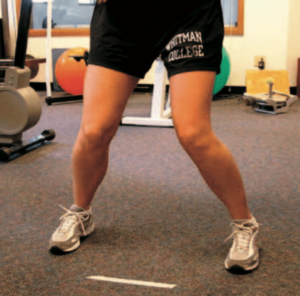Understanding Valgus

If you have ever attended one of my courses, you will hear me refer to valgus as “the boogeyman of the knee”. We seem to blame it for a lot of issues and see it as the root of all evil when it comes to the knee joint. This view is not inherently wrong, but it represents a basic misunderstanding.
What is valgus?
Valgus as a term is a little vague. All it means is “outward from center” which is not terribly specific. What you will notice when reading the literature is that researchers use different terminology. Classic “valgus” is usually stated as “knee abduction”. Imagine the knee abducting the same way a hip would – Not really a movement the knee does…
But this is not the boogeyman that I’m talking about. The valgus we all fear is typically referring to “dynamic valgus” which is *simply relative internal rotation of the lower extremity against a relatively fixed foot and pelvis.*
*Edited from “…a combination of knee abduction with relative internal rotation of the femur against relative external rotation of the tibia” which is not always right and it’s beyond the scope of this article to explain why. Exact forces at the knee vary which gets into kinematics vs kinetics.

Dynamic valgus of both knees
It’s not “good” or “bad”. It’s just a thing. A thing that does stuff. Too vague?
Dynamic valgus tears ACLs
Yes it does…technically. But that is an oversimplified, piss-poor understanding of the mechanism of injury. Dynamic valgus IN A VERY SPECIFIC ENVIRONMENT tears ACLs. When we look at video evidence of people actually tearing their ACLs, we consistently see the tears occur in less than 30 degrees of knee flexion – the average position being around 23 degrees of flexion. Knee flexion is an extremely good shock absorber. When you rapidly load a lower extremity and the knee refuses to bend more than 30 degrees, you have a very serious load management issue.
Physics demands that you absorb that shock and the motion involved in dynamic valgus can work as a shock absorber. Unfortunately, dynamic valgus in less than 30 degrees of flexion puts that load right into the ACL as shown by one of the most beautiful basic science studies that I have ever read. If that load exceeds the load tolerance of the ACL – KAPLOOEY!
So the system fails to absorb rapid load, going into dynamic valgus at the last second as an “all else has failed” strategy. And when I say “last second” I mean around 4/100ths of a second after initial contact – way faster than the best conscious human reaction time. The dynamic valgus is not so much a “coordination issue”, it is merely a last ditch effort to manage load. It is better described as the straw that broke the camel’s back.
When a straw breaks a camel’s back, you don’t blame the straw.
Train the athlete to handle that rapid load better. Make it so that knee flexion is a better option for that athlete. Trying to just take away their valgus is like trying to take away a car’s bad set of shocks and not replacing them with a better one. Knee flexion, with or without the dynamic valgus, is much more forgiving.
One thing you need in order to achieve knee flexion during cutting motions is a lot of quadriceps strength and power. Give them that. If they are getting the knee flexion during cutting, I would worry less about the valgus.
Dynamic valgus contributes to patellofemoral pain (PFP)
Yes it does…technically. Since at least 1984 we have plenty of biomechanical evidence that as valgus increases, contact pressures (loads) in the patellofemoral joint increase. Aha! That must explain the problem! (I even wrote a paper about it years ago.)
Loads increase all the time for many different reasons during activities. When throwing a baseball, as velocity increases, shoulder loads increase. As the weight lifted increases during squats, knee loads increase. As running distances increase, cumulative knee loads increase. But is this “bad”?
The argument that you must get rid of dynamic valgus FOREVER to prevent PFP is the same argument as telling a baseball pitcher that they must reduce their velocity forever to avoid a future shoulder injury or a weight lifter that they need to stop lifting so much weight or they’ll blow out their knees in the future. Or more running inherently equals more injuries.
It all comes down to load tolerance. If the tissue can handle the loads applied to it, then THE TISSUE CAN HANDLE THE LOADS APPLIED TO IT! Derp. So if the athlete has been doing it for a long time without problems, it is unlikely to cause an injury at this point.
How does the tissue develop load tolerance? Through systematic, progressive conditioning of that tissue to load. PFP is best explained as overloaded tissue reacting to more load than it can tolerate. Because dynamic valgus increases load to the patellofemoral joint it can contribute to the pain, but the cause is simply the application of load beyond the amount that the tissue has been conditioned to tolerate. For example, they may have always had dynamic valgus; increasing running mileage too fast may be the actual culprit.
Now, yes, you could try to reduce those loads by limiting someone’s tendency to go into dynamic valgus, but you might as well try to achieve world peace while you’re at it. Turns out that is really REALLY hard to achieve. Good luck with that.
Research has shown for a very long time that progressively loaded leg extensions are an effective tool for treating PFP. But leg extensions are known to increase the load to the patellofemoral joint JUST LIKE VALGUS?! What gives?
Yeah, you are simply conditioning the patellofemoral joint to tolerate more load. After most “coordination training” interventions, when the patient goes back to their activities, the valgus is still there (unless your training is VERY task specific and externally focused). They only have less pain if the joint now tolerates the load. Simple as that.
An aside: There are some simple, intuitive techniques that lower overall load to the system (not just the knee) that have been shown to be effective load management strategies. An example is increasing running cadence. Pick music at the right bpm and simply run along to it. No “squeezing glutes”. No “pointing your knees in the right direction”. Just bop along.
Changing dynamic valgus
Now some of you would say, “But if I could reduce the valgus, then why wouldn’t I?” I understand the point and it’s not inherently “wrong” but I have a couple things for you to think about first. Is the person having problems SO FAR or do they just “move funny” in your opinion? Maybe their patellofemoral joint “likes” load for some reason. Maybe correcting that mild dynamic valgus (assuming you could), would just make their hip or back start having issues. If there isn’t a problem, leave them alone. Better yet, just get them stronger.
Especially with a high level athlete. They got to that level moving that way. Be careful messing around too much with that. Also keep in mind that in general, we really suck at predicting specific injuries based on movement.
Now, I’m not saying that I would actually encourage dynamic valgus during a task. However, some argue that systematically and progressively training into valgus can build resilience to the acquired loads. One could also argue that gaining exposure to dynamic valgus gives the athlete practice coming out of it – handy when they find themselves there accidentally during sport (I have my doubts about the “trainability” of this). There is evidence that people who demonstrate dynamic valgus landing mechanics but have not yet sustained a knee injury may have developed protective hip strength as a response to the dynamic valgus.
Trying to prevent injuries by teaching athletes to avoid dynamic valgus forever is like trying to prevent sexually transmitted diseases by teaching teenagers to practice abstinence forever. At some point it’s going to happen and they won’t have the tools to stay safe.
Similar to my feelings on reducing dynamic valgus, encouraging progressive exposure to dynamic valgus as a training tool is not inherently “wrong”. But, as with everything, there is a lot to consider.
In my opinion, if someone has really good strength, power, and load tolerance overall (not JUST quads but AT LEAST quads), you have probably done more for them than you would by “fixing” their techniques. People are weird and unique. What works for one person may not work for another. This variation is beautiful and wonderful and should be embraced. Human movement is an amazingly complicated mess of components way beyond the capacity of your simple mind.
Try not to look stupid.
In summary…
- Dynamic valgus is a thing, but it isn’t the boogeyman many make it out to be
- To sustain a non-contact ACL tear you need dynamic valgus, but you need other things as well
- Dynamic valgus adds load to the patellofemoral joint, but the joint can become conditioned to tolerate it
- Variation of movement is a beautiful and wonderful thing
- You’re dumber than the human body, and that’s ok
The featured image on this post is “WBB Athlete of the Week” by Big West Conference via Flicker.
“Dynamic valgus of both knees” is from a paper I wrote more than 10 years ago that was just awful in hindsight…
